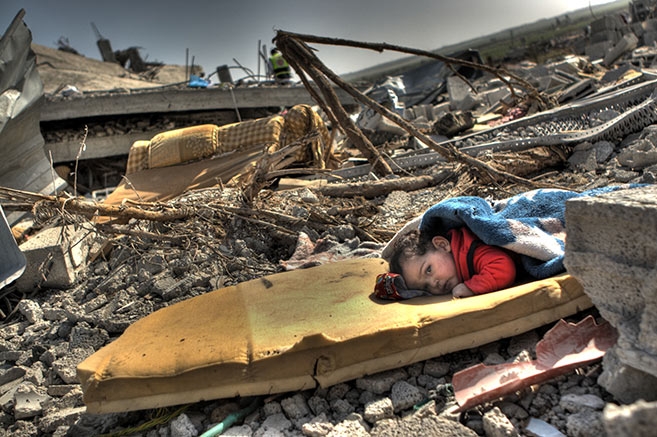It is evident by now from data collection, evidence-gathering and research, that the use of explosive weapons in populated areas causes a persistent pattern of harm which is severe. This has been documented across a range of different contexts.

Photo © Marc Garlasco
The so-called ‘reverberating’ or knock-on effects from explosive weapon use can be less immediately visible than the direct effects, but the civilian deaths, injuries and other harms that result from the incidental destruction of housing and infrastructure can far outweigh the immediate civilian death toll from an attack.
These reverberating effects can be experienced by people in areas far beyond the location of the initial attack, and can be felt for weeks, months or even years afterwards.
In Mosul, 80% of the housing was destroyed. Four years on, an estimated 300,000 were still displaced. Entire neighbourhoods have yet to be rebuilt, and basic services and poor sanitation has led to serious public health problems. In Raqqa, the city’s water irrigation system was destroyed, and although access to water has improved, water quality and sewage issues persist, impacting not only the Raqqa province but areas outside as well. And in both of these cities explosive remnants of war have stopped many from returning and rebuilding their lives.
These experiences – and other experiences of civilian harm in recent conflicts, are both severe and significant, and they underscore the importance of giving due weight to understanding the full extent of harms.
Working to understand the full range of reverberating effects and how people are impacted is an important step towards being able to prevent and respond to harm, which is what we should be aiming for. The research indicators that UNIDIR has developed are an important tool for starting to do this.
By looking at how explosive weapons function, it can help with understanding why these weapons and their use in urban environment deserve specific attention.
Explosive weapons are characterised by the use of high explosives to create blast and fragmentation in the area around the point of a detonation.
These weapons can exert very powerful mechanical forces with lethal effects, often causing multiple casualties from a single use, and capable of seriously damaging or destroying buildings – an important part of the perceived military utility of some types of heavy explosive weapons.
When used in built-up environments the capability of seriously damaging or destroying buildings and infrastructure create elevated humanitarian risks.
Explosive weapons that have wide area effects are particularly problematic. This is the case when explosive weapons have a large destructive radius, an inaccurate delivery system, or the capacity to deliver multiple munitions over a wide area.
The explosive force and blast wave can cause buildings to collapse, including neighbouring structures beyond those that are directly hit, sometimes across wider surroundings.
Multiple explosive weapons launched at an area or inaccurate delivery of an explosive weapon can hit buildings within an area that are not the intended targets.
And because essential public service infrastructure is concentrated in towns and cities, this presents an elevated risk of damage to healthcare and education facilities, water and sanitation, shelter, and power–which greatly exacerbates the impact of conflict.
When explosive weapons have wide area effects it not only increases the risk of killing or injuring civilians in that area, it also increases the risk of creating ‘reverberating’ effects as a result of damage to property, buildings, and infrastructure upon which people depend – effects that flow from the inter-dependence of infrastructure and services.
Even when used with caution, and when used by parties that claim to be acting in accordance with the law – we can still cause grave harm to civilians.
Yemen is a case in point, as research by Humanity and Inclusion shows. Hodeidah Port is Yemen’s largest port and a vital lifeline for food security. Yemen is highly dependent on imports delivered mostly by sea. Before the conflict, Yemen imported nearly 90% of its goods. The ports on the Red Sea are the only harbours in Yemen with sufficient berthing space to receive large container ships and storage facilities to receive large quantities of necessary goods.
In August 2015, Hodeidah Port was heavily damaged by airstrikes that destroyed the port’s control towers, main gantry cranes, and several of the warehouses.
This damage immediately reduced the port’s capacity to receive critical imports, including the food, medicine, and fuel upon which Yemen depends. After the incident, it took six weeks for one crane to be repaired.
As a result, food prices rose across Yemen – exacerbating an existing crisis where already 16 million people are severely food insecure.
And reduced port capacity meant that not only was Yemen receiving less food, but also smaller amounts of the fuel needed to power generators that enable Yemen’s water systems, health facilities, and even the transport of goods.
This is just one example of many – the importance of public services and infrastructure in the midst of a crisis cannot be understated.
The law requires parties to take into account the foreseeable effects when launching an attack
This includes “incidental loss of civilian life, injury to civilians, damage to civilian objects, or a combination thereof”, through the rule on proportionality and requirement to take all feasible precautions in attack.
But despite this, civilian harm from reverberating effects remains extensive.
In part this is because what is “reasonably foreseeable” is not well defined nor agreed, and is perhaps anyhow it is going to be somewhat uncertain.
This includes the scope of what is reasonably foreseeable across a geographical space, and over a period of time.
Gathering the information needed to foresee effects in a particular instance could require extensive assessments drawing on a range of different areas of technical expertise to form understandings of how to protect civilian populations – such as with engineers and other professionals to know the location of infrastructure, and to assess the likely knock-on effects of damage to healthcare or, water distribution.
And this is perhaps easier in certain situations than others – such as in pre-planned attacks where there is more time to consult with technical experts, or making broader assessments such as in situations where there have been repeated attacks in a populated area and where the risk of cumulative impacts is especially evident.
The on-going diplomatic discussions to develop an international political declaration on the use of explosive weapons in populated areas, provide an important opportunity to strengthen the protection of civilians.
In these discussions, states and organisations have called for the reverberating effects of explosive weapons to be both recognised and be more effectively factored in to the planning of military operations, and the current draft declaration text, reflects this. The text:
– Recognises that when critical civilian infrastructure is damaged and destroyed, it impacts the provision of essential services, noting also the interconnected nature of these services in towns and cities, where damage and destruction to one component of the infrastructure or service, can negatively affects services elsewhere, causing harm to civilians fay beyond the weapon’s impact area.
– It also requires militaries to factor in the foreseeable reverberating effects, into the planning of their military operations.
The political declaration holds the potential to provide an effective tool to guide militaries in better factoring in reverberating effects in the planning of military operations, and in military practice.
There are a number of ways in which the declaration can help towards this, and this includes considerations of areas where the text can be strengthened in its commitments and clearer and more specific in its guidance to states.
First, the agreement of the political declaration will create greater awareness of the immediate risks of death and injury to civilians, the risks of damage and destruction of buildings and critical infrastructure, and the broader knock on effects of this for civilians. It will make it clear that these knock-on effects are foreseeable and establish a presumption that reverberating effects are to be expected in populated areas where critical infrastructure is densely concentrated.
But it should also contain a series of politically binding commitments on endorsing states.
A declaration should explicitly require militaries to undertake prior assessment of the effects of weapon systems, to understand their area effects, the sorts of mechanical forces they produce and how these are affected by the urban environment – so states better understand the extent of structural and other damage weapons will cause in a populated area to assist decision-making, including avoiding use in the first place.
And the declaration should encourage states to better assess the specific context of use and the presence of civilians and interconnected infrastructure, to understand the risks to civilians and how essential services will be affected if they are damaged or destroyed, and to continue to factor these assessments into decision-making even in dynamic situations.
A declaration should also require states to gather data on the use of explosive weapons in populated areas, and the effects on civilians including reverberating effects.
And fundamentally, a declaration should commit states to avoid using explosive weapons with wide area effects in populated areas due to the inherent risk of harm to civilians. This would provide the strongest protection to civilians from death and injury while also reducing the risk of damage and destruction of critical infrastructure.
Lastly, a declaration can help to build a community of practice among states and organisations that come together on a regular basis to review civilian harm from the use of explosive weapons in towns and cities, share experiences of military operations in urban settings and that look at empirical data and evidence in the public domain on the impacts on civilians.
By doing this it can provide important lessons that can in turn provide greater foresight in planning of future military operations.
